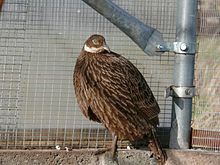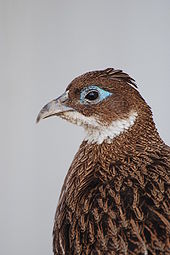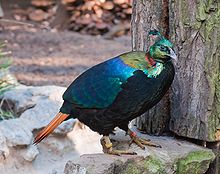- Himalayan Monal
-
Himalayan Monal (Danphe) 
Female at Fife Animal Park, Scotland Conservation status Scientific classification Kingdom: Animalia Phylum: Chordata Class: Aves Order: Galliformes Family: Phasianidae Subfamily: Phasianinae Genus: Lophophorus Species: L. impejanus Binomial name Lophophorus impejanus
(Latham, 1790)The Himalayan Monal, Lophophorus impejanus also known as the Impeyan Monal or Impeyan Pheasant or Danphe is a bird of genus Lophophorus of the pheasant family, Phasianidae. It is the national bird of Nepal, where it is known as the Danfe, and the state bird of Uttarakhand.
Traditionally, the Himalayan Monal has been classified as monotypic. However, studies have shown that the male Himalayan Monals of northwestern India lack the white rump that other Himalayan Monals have, and have more green on the breast, indicating the possibility of a second subspecies. [2]
The scientific name commemorates Lady Mary Impey, the wife of the British chief justice of Bengal, Sir Elijah Impey.
Contents
Description
It is a relatively large-sized bird with reference to family Phasianidae. About 70 cm in length, the weight of males and females range between 1980-2380g and 1800-2150g respectively. Adult males possess a long crest, are feathered with multicoloured plumage throughout their body, while the females, like in other pheasants, are dull in colour with the upper parts covered with dark brownish-black feathers. Notable features in males are a long crest that is metallic green, changeable reddish copper on the back and sides of the neck, and a prominent white back and rump while in flight (birds of northwestern India lack this). Tail feathers of males are uniformly rufous being darker towards the tips, whereas the lower tail coverts of females are white, barred with black and rufous. Females have a prominent white patch in the fore neck and a white strip on the tail. First year males and immatures resemble females, but first year males are larger and the immatures are less distinctly marked.
Biology and Social Behaviour
Details are provided at the 'Pheasants of Pakistan' website [3]
Distribution and habitat
The Himalayan Monal secures a distinct position among pheasants due to its prominent build, brilliant plumage and strong association with local folklore. Its natural range spreads from eastern Afghanistan through the Himalayas including Kashmir region of Northern Pakistan, India (states of Himachal Pradesh, Uttarakhand, Sikkim and Arunachal Pradesh), Nepal, southern Tibet and Bhutan. There is also a report of its occurrence in Burma. It occupies upper temperate oak-conifer forests interspersed with open grassy slopes, cliffs and alpine meadows between 2400 – 4500m, mostly concentrating in a narrow belt of 2700 – 3700m. They seem to exhibit clear and fluctuating altitudinal migration reaching as low as 2000m in winter. They, however, show tolerance to snow and have been observed to dig through snow for roots, tubers and other plant parts, and invertebrates. Seen in pairs during the breeding season (April to August), they form large coveys and involve in communal roosting during the winter. The population of this species in most of its range is threatened due to poaching and other anthropogenic factors. The male monal has been under heavy hunting pressure for its crest feather, which was used for ornamental hats of Himachal men, until 1982 when legal hunting was banned in the state.
In popular culture
In the 2009 Disney-Pixar Film Up, the large flightless tropical bird "Kevin" (which is actually a female) is based upon the iridescent appearance of a male Himalayan Monal found at the Sacramento Zoo.[4] The bird, named Genghis, has since died.[5]
Scottish band Mogwaï played a song called Danphe and the Brain on their album The Hawk is Howling.
Bibliography
References
- ^ BirdLife International (2004). Lophophorus impejanus. 2006. IUCN Red List of Threatened Species. IUCN 2006. www.iucnredlist.org. Retrieved on 9 May 2006. Database entry includes justification for why this species is of least concern.
- ^ http://www.gbwf.org/pheasants/monal.html
- ^ http://www.wildlifeofpakistan.com/Himalayan_Monal.htm
- ^ http://www.sacbee.com/breaking/story/1885328.html
- ^ http://www.sacbee.com/ourregion/story/2225406.html
External links
Categories:- IUCN Red List least concern species
- Lophophorus
- Birds of Asia
- Birds of Bhutan
- Birds of China
- Birds of India
- Birds of Burma
- Birds of Nepal
- Birds of Pakistan
Wikimedia Foundation. 2010.



